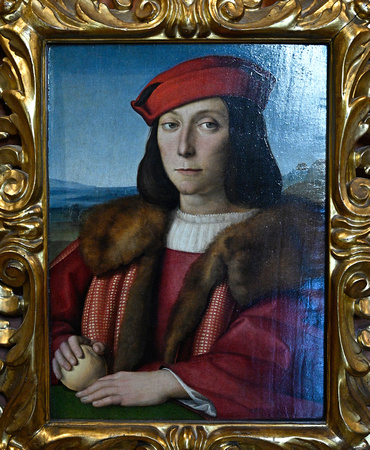The Young Man with an Apple is an oil on wood painting by the
Italian High Renaissance painter
Raphael, executed
c. 1505. It is housed in the
Uffizi Gallery in
Florence. Made during the artist's Florentine period, it is often thought to be the portrait of
Francesco Maria I Della Rovere.
[1] He was born in
Senigallia, the son of the Papal captain and lord of that city,
Giovanni della Rovere, and of Giovanna da Montefeltro, daughter of
Federico III da Montefeltro. He was also the nephew of
Giuliano della Rovere, Pope Julius II.
Portrait of Eleonora Gonzaga by
Titian, 1538
His uncle
Guidobaldo I of Urbino, who was heirless, called him at his court, and named him as heir of that dukedom in 1504 through the intercession of Julius II. In 1502 the della Rovere had lost the seigniory of Senigallia, occupied by
Cesare Borgia, then the most powerful figure in the
Marche: Francesco Maria and his mother were saved from the slaughter perpetrated by Borgia's troops by the then-land soldier
Andrea Doria. When in 1508 Guidobaldo died, Francesco Maria became
duke of Urbino; thanks to the support of his uncle the pope he could also recover Senigallia after Borgia's death.
In 1508 he married
Eleonora Gonzaga (1493–1570), daughter of
Francesco II Gonzaga, Marquess of Mantua and
Isabella d'Este.
Figure from
Raphael's
The School of Athens (1509–11), possibly Francesco della Rovere, although others think it is the philosopher
Giovanni Pico della Mirandola.
[2][3] In 1509 he was appointed as
capitano generale (commander-in-chief) of the
Papal States, and subsequently fought in the
Italian Wars against
Ferrara and
Venice. In 1511, after he had failed to conquer
Bologna, he had the cardinal
Francesco Alidosi killed by his troops, a cruel action for which he was compared to Borgia himself. In 1513 he was created also lord of
Pesaro.
However, the death of Julius II deprived him of his main political patron, and under the new pope,
Leo X, Pesaro was given to the latter's nephew,
Lorenzo II de' Medici. In 1516 he was excommunicated and ousted from Urbino, which he tried unsuccessfully
to recover the following year. He could return in his duchy only after Leo's death in 1521.
Young Man with an Apple, portrait of Francesco Maria as a teenager by
Raphael, 1504.
Della Rovere fought as
captain general of the
Republic of Venice in
Lombardy during the
Italian Wars of 1521 (1523–1525), but with the new Medici Pope,
Clement VII, the della Rovere were increasingly marginalized. As supreme commander of the Holy League, his inaction against the Imperial invasion troops is generally listed as one of the causes of the
Sack of Rome (1527).
He was a protagonist of the capture of
Pavia in the late 1520s, and later fought for the
Republic of Venice. Later he arranged the marriage of son
Guidobaldo to Giulia
da Varano (belonging to another former seigniory family of the region) to counter the Papal power in the
Marche.
He died in Pesaro, poisoned. Some scholars suggest that
The Murder of Gonzago, an unknown play referenced in
William Shakespeare's Hamlet, Prince of Denmark, which is itself later reworked by Hamlet into
The Mousetrap (the play within the play), may have been a popular theatrical reenactment of Della Rovere's death and may have been portrayed in England's early theaters during the
Elizabethan Era.


